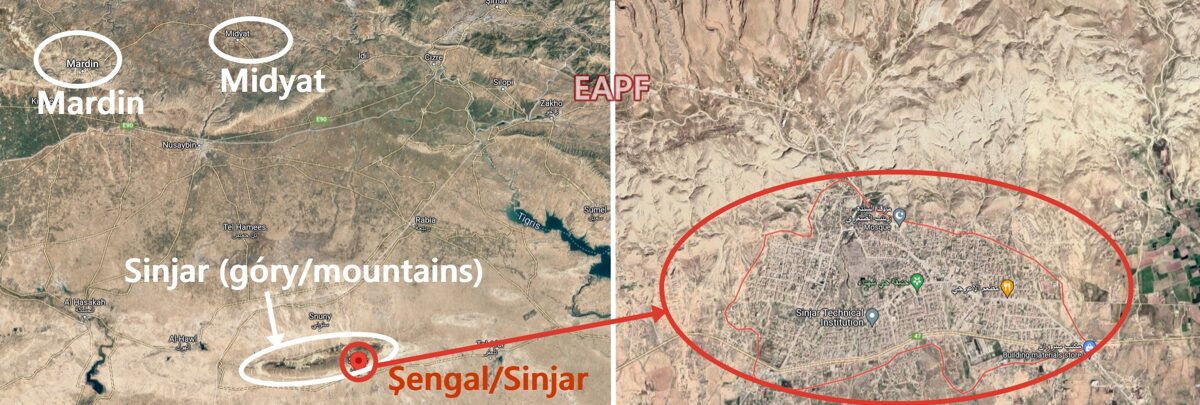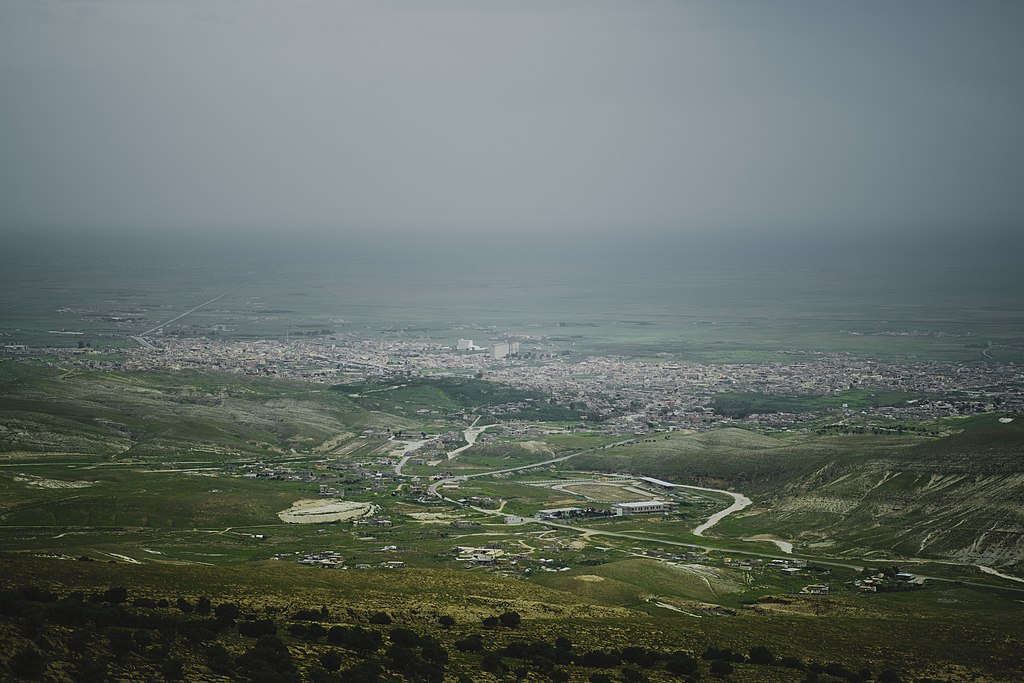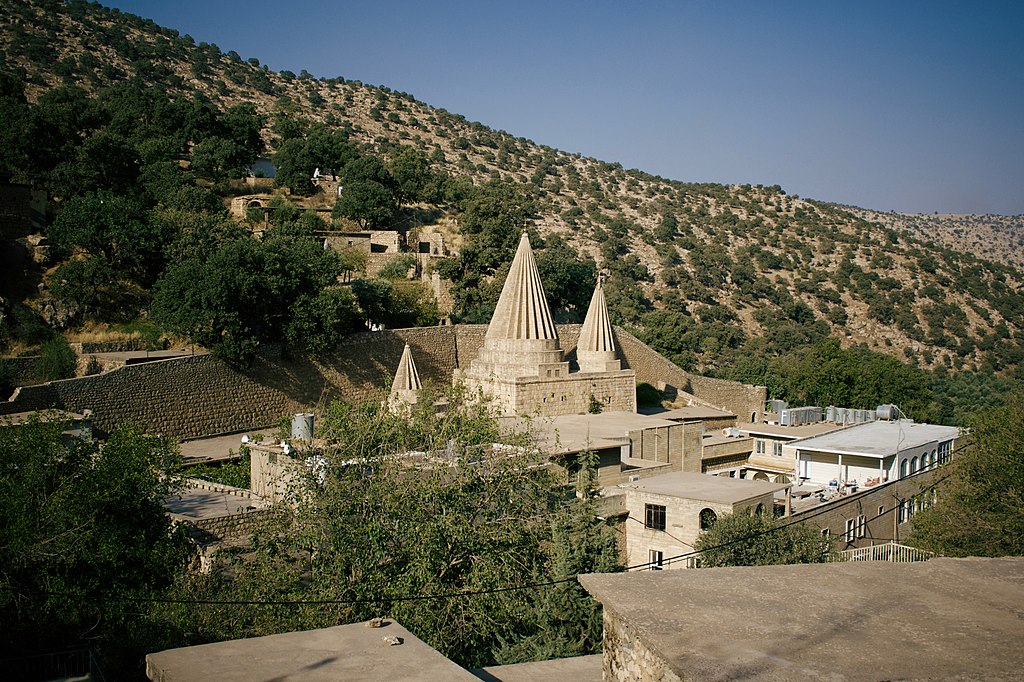Kaçış i Jezydzi
FOR ENGLISH SEE END OF NOTE
Jak się dowiadujemy z opisu serialu, opowiada on o historii ucieczki dziennikarzy, którzy pojechali do jezydzkiej wioski i tam, po ataku na nią, znaleźli się w niewoli. Z kurdyjskiej strony RUDAW, dowiadujemy się, że dziennikarze pojechali do Şengal.
Şengal to turecka nazwa miasta i prowincji Sinjar (Sindżar) w północnym Iraku, na terenie Kurdystanu, niegdyś starożytnej Mezopotamii, około 5 km od gór o tej samej nazwie. Jak widać na mapie, jest to stosunkowo niedaleko granicy z Turcją, na południe od Mardin i Midyat.

Miasto i okoliczne wioski zamieszkane były głównie przez jazydów [inna nazwa: jazydzi] - etnicznie Kurdów, ale uznających się za osobną nację wyznawców monoteistycznej religii mającej ok 4 tys lat, a więc znacznie starszej niż chrześcijaństwo. Jazydzi wierzą, że pochodzą od samego Adama i że Bóg stworzył ziemię i powierzył ją siedmiu Świętym Istotom - Aniołom, z których najważniejszym był Malak Tawuk, czyli Król-Paw.
 Miasto Sindżar miało bardzo burzliwą historię, przechodziło z rąk do rąk, a sami Jazydzi często byli obiektem prześladowań. Naliczyli, że było ich 74 (niektóre źródła podają 73). Zarówno chrześcijanie, jak i Muzułmanie uznawali ich za wyznawców Szatana (uznali bowiem, że Król-Paw to Szatan). Ostatnie prześladowanie miało miejsce w sierpniu 2014 r, gdy bojownicy ISIS wtargnęli do miasta, zabijając tysiące jazydów z niebywałym okrucieństwem (poza masowymi egzekucjami z obcinaniem głów włącznie, zakopywali ich żywcem albo palili). Kobiety i małe dziewczynki stały się przedmiotem handlu i niewolnicami seksualnymi, a część ofiar gwałtu wg świadków, popełniła samobójstwo skacząc z góry Sinjar. Małych chłopców z kolei zabrano do obozów, gdzie ćwiczono ich na bojowników ISIS.
Miasto Sindżar miało bardzo burzliwą historię, przechodziło z rąk do rąk, a sami Jazydzi często byli obiektem prześladowań. Naliczyli, że było ich 74 (niektóre źródła podają 73). Zarówno chrześcijanie, jak i Muzułmanie uznawali ich za wyznawców Szatana (uznali bowiem, że Król-Paw to Szatan). Ostatnie prześladowanie miało miejsce w sierpniu 2014 r, gdy bojownicy ISIS wtargnęli do miasta, zabijając tysiące jazydów z niebywałym okrucieństwem (poza masowymi egzekucjami z obcinaniem głów włącznie, zakopywali ich żywcem albo palili). Kobiety i małe dziewczynki stały się przedmiotem handlu i niewolnicami seksualnymi, a część ofiar gwałtu wg świadków, popełniła samobójstwo skacząc z góry Sinjar. Małych chłopców z kolei zabrano do obozów, gdzie ćwiczono ich na bojowników ISIS.
Warto poznać tutaj historię Nadii Murad, która straciła matkę i 6 braci, a sama została niewolnicą seksualną. Udało się jej zbiec i od tamtej pory walczy na arenie międzynarodowej o prawa mniejszości religijnych i przeciwko przemocy wobec kobiet - w 2018 otrzymała Pokojową Nagrodą Nobla (razem z Denisem Mukwege) „za wysiłki mające na celu zaprzestanie używania przemocy seksualnej jako narzędzia wojny i konfliktów zbrojnych”.
 Części jazydów udało się uciec z Sindżar i schronić w ich świętym miejscu Lalish [Lalisz, na zdjęciu], które dla nich jest tym co Jerozolima czy Mekka, a także w górach Sinjar, skąd potem przedostali się do Syrii i innych krajów (wielu znalazło azyl w Niemczech). Część jednak, uwięziona w górach, otoczonych przez siły Isis, zmarła z głodu i odwodnienia.
Części jazydów udało się uciec z Sindżar i schronić w ich świętym miejscu Lalish [Lalisz, na zdjęciu], które dla nich jest tym co Jerozolima czy Mekka, a także w górach Sinjar, skąd potem przedostali się do Syrii i innych krajów (wielu znalazło azyl w Niemczech). Część jednak, uwięziona w górach, otoczonych przez siły Isis, zmarła z głodu i odwodnienia.
Miasto Sindżar jest w większym stopniu zrujnowane, co możecie zobaczyć na google.
Kiedyś mieszkali tam przedstawiciele kilku religii: przede wszystkim Jazydzi, ale także Muzułmańscy Sunnici i chrześcijanie - były tam trzy kościoły, ale wszystkie zostały zburzone w wyniku ataku ISIS. Pierwotni mieszkańcy nie chcą i nie bardzo mają do czego wracać, nie mówiąc o traumie, jaką nadal przeżywają, po tym co tam się stało. Poza tym, nawet po 2014 r, nie było tam spokoju - w 2021 tureckie siły zbrojne przeprowadziły tam operację powietrzną i naziemną [Pazur-Orzeł i Pazur-Tygrys] skierowaną przeciwko Kurdom. Jest obawa, że może dojść do całkowitej eksterminacji Jazydów i ich kultury, stąd działacze ciągle apelują do Narodów Zjednoczonych o pomoc humanitarną i schronienie…
Warto wspomnieć, że temat tragedii Jazydów po ataku ISIS pojawia się w polsko-niemieckim filmie (z 2022) reżyserki Hanny Polak pt. “Anioły z Sindżaru”. Film nominowany jest do Oskara i nagrody Emmy.
Zwiastun i streszczenie można zobaczyć np. https://www.kinomuza.pl/movie/anioly-z-sindzaru/.
***********************************************
Wpis został opracowany na podstawie informacji z Wikipedii oraz podanych niżej artykułów, w których możecie znaleźć więcej informacji:
Dodałam także trochę informacji w adnotacjach do notatki - "Dwoje pisarzy i jeden serial"
Warto też przeczytać opis podróży do Lalish z blogu Trekmondo [ z pięknymi zdjęciami] - Jazydzi z Lalish
- Informacje o Jezydach i ich religii - https://www.focus.pl/artykul/kim-sa-jezydzi-przesladowani-przez-ekstremistow-w-iraku
O prześladowaniach Jezydów:
-
https://wyborcza.pl/osiemdziewiec/7,159012,22188639,siedemdziesiate-czwarte-ludobojstwo-minely-trzy-lata-od.html
-
https://amnesty.org.pl/ucieczka-z-gory-sindzar-ale-co-dalej/
-
https://centrumwielokulturowe.waw.pl/en_gb/rocznica-masakry-w-sindzarze-aniversary-of-sinjar-genocide/
Zdjęcia/Photos: Wikipedia
Widok na Sindżar z góry Sindżar By Levi Clancy - Own work, CC0, https://commons.wikimedia.org/w/index.php?curid=79030949
Lalish - Levi Clancy, CC BY-SA 4.0 <https://creativecommons.org/licenses/by-sa/4.0>, via Wikimedia Commons
***********************
TEXT IN ENGLISH
As we learn from the description of the series, it tells the story of the escape of journalists who went to a Yezidi village and were captured there, after the attack of an extremist group. From the Kurdish media site of RUDAW, we learn that journalists went to Şengal.
Şengal is the Turkish name of the city and province of Sinjar in northern Iraq, in the territory of Kurdistan, once ancient Mesopotamia, about 5 km from the mountains of the same name. As you can see on the map [see above], it is relatively close to the Turkish border, south of Mardin and Midyat. The city and the surrounding villages were inhabited mainly by Yazidis [another name: Yezidis], who are ethnically Kurds, but who consider themselves a separate nation and who are followers of a monotheistic religion that is about 4,000 years old, and therefore much older than Christianity. The Yazidis believe that they are descendants of Adam himself and that God created the earth and entrusted it to the seven Holy Beings - Angels, the most important of whom was Malak Tawuk, or King-Peacock.
The city of Sinjar had a very turbulent history, passing from hand to hand, and the Yazidis themselves were often subject to persecutions. They counted that there were 74 of them (some sources say 73). Both Christians and Muslims regarded them as followers of Satan (as they consider the King-Peacock, worshipped by the Yazidis as Satan). The last persecution took place in August 2014, when ISIS fighters stormed the city, killing thousands of Yazidis with extreme cruelty (apart from mass executions, beheading included, they buried them alive or burnt them). Women and little girls were victims of sex trafficking and became sex slaves; some rape victims, according to witnesses, committed suicide by jumping off Mount Sinjar. The little boys, on the other hand, were taken to camps where they were trained to become ISIS fighters.
It is worth knowing the story of Nadia Murad, who lost her mother and 6 brothers, and became a sex slave herself. She managed to escape and has since been fighting internationally for the rights of religious minorities and against violence against women - in 2018 she was awarded the Nobel Peace Prize (together with Denis Mukwege) for "their efforts to end the use of sexual violence as a weapon of war and armed conflict. "
Some of the Yazidis managed to escape from Sinjar and take refuge in their sacred place Lalish [pictured above], which for them is what Jerusalem or Mecca is for Christians or Muslims, as well as in the Sinjar Mountains, from where some managed to escape to Syria and other countries (many found asylum in Germany). Some, however, trapped in the mountains, surrounded by ISIS forces, died of starvation and dehydration.
The city of Sinjar is almost completely destroyed, as you can see on google. It used to be home to several religions: primarily Yazidis, but also Sunni Muslims and Christians - there were three churches there, but they were all destroyed after an ISIS attack. The original inhabitants do not want to return to the area and many have nothing to return to, not to mention the trauma they are still experiencing after what happened there. Moreover, even after 2014, there was no peace there - in 2021, the Turkish armed forces conducted an air and ground operation [Claw-Eagle and Claw-Tiger] against Kurds there. There is a fear that the total extermination of the Yazidis and their culture may take place, hence the activists constantly appeal to the United Nations for humanitarian aid and shelter ...
It is worth mentioning that the topic of the Yazidi tragedy after the ISIS attack appears in the Polish-German film (2022) by director Hanna Polak, entitled Angels of Sinjar. The film is nominated for an Oscar and an Emmy. You can see the trailer above.